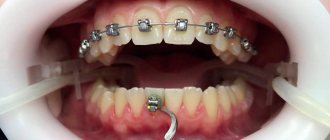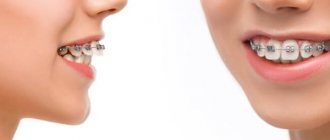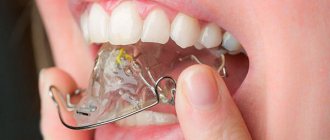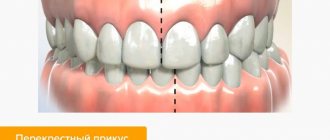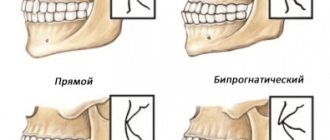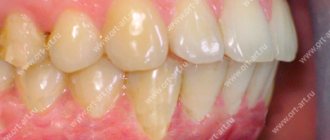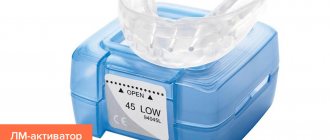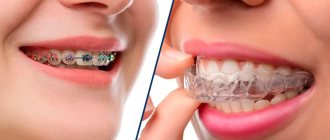Malocclusion and crooked teeth are quite common anomalies, diagnosed in more than 60% of patients in dental clinics. In some cases, the defects are minor and do not cause significant inconvenience, which makes it possible to do without medical intervention. In other situations, installing braces helps prevent the development of more serious pathologies, as well as restore the functionality and aesthetics of the jaw. Modern models of correctors are noticeably different from the bulky and inconvenient designs used in the last century - aesthetic, small-sized systems provide greater efficiency, allow you to control the progress of treatment, and are practically invisible to others. Among the popular options offered by leading manufacturers, H4 braces from OC Orthodontics deserve special attention.
What are H4 braces?
The structures are manufactured by the famous American company Ortho Classic. The bracket system consists of a forming arch and braces. The arch is necessary to create the contour of an ideal smile and is secured using special locks.
The system is based on self-ligating (blocking) staples to hold the arc. No more rubber bands or wires! This minimizes the pain of treatment and the likelihood of side effects.
In fact, there is no other product that can treat bites so elegantly. Self-ligating H4 braces are smaller than other systems and move teeth with light pressure and low friction. As a result, they are more comfortable for the patient and provide faster results than typically achieved with braces.
Orthodontist at the Stimul clinic Olga Vladimirovna Pavlyukova
Advantages of self-ligating braces
The first systems for correcting the position of teeth had ligatures. These are special elastic loops that secure the plates to the arches. They showed effectiveness, but were not aesthetically pleasing or comfortable enough. In addition, the patient was forced to constantly come to the doctor so that he could “adjust” the design.
Unligated systems do not have such loops. Instead, they use clips, with the help of which the arch is fixed to the braces. They are easy to open (in a medical office setting) to change the tension level. In addition, the teeth do not encounter strong resistance, and as a result, their position becomes more natural and physiological.
Let us summarize the advantages of self-ligating structures:
- higher speed of bite correction;
- no need to visit the orthodontist every 30 days (the frequency of visits depends on the treatment program, but, as a rule, you need to come to the clinic no more than once every two months);
- ease of care (caring for braces without ligatures is only a little more difficult than caring for teeth without any fixed structures);
- comfort when wearing (the patient quickly gets used to it, speech and appearance do not change, and you can continue your active social life and work).
Self-ligating systems are convenient, save time, and shorten the period of bite correction.
Preparation and installation process
Preparations for treatment begin after the dentist has confirmed the need to install braces. The first step is to cure diseased teeth and gums, if any.
The further work algorithm includes the following procedures:
- panoramic photograph of the oral cavity;
- photographs of the face and teeth;
- making impressions of the dentition;
- articulation study.
If necessary, patients are given consultations with related specialists: a surgeon or an implantologist.
On the appointed day, the patient must first eat a hearty meal. The installation process occurs using a direct or indirect method. Each bracket can be glued to each tooth individually, or the entire structure can be installed through aligners.
The installation itself takes at least an hour and a half. It is painless and does not require anesthesia.
- Professional oral hygiene is performed.
- The enamel is treated with a protective compound.
- Primer and special glue are applied.
- The braces are fixed and excess glue is removed.
- The result is recorded under a light lamp.
Preparing for installation
The orthodontist cannot immediately install braces. Before this you need:
- cure all teeth that require it: any caries, inflammation of the gums can lead to big problems while you wear a metal structure;
- carry out professional cleaning that will remove tartar and plaque;
- come for a preliminary examination to the orthodontist: he will assess the condition and prescribe additional examinations;
- take a panoramic photo in the X-ray room: it will show hidden areas, help develop a treatment program, as well as impressions;
- carry out sanitation of the oral cavity immediately before installing the system.
The first two stages can be completed in any clinic where you are used to being treated. But it's better to do everything in one place.
Duration of treatment with H4 braces
The duration depends on the initial position of the teeth. The average duration of wearing the systems is a year. Thanks to more precise tooth movement, treatment times with this system are 25% shorter than traditional structures.
Often patients want to give up braces after six months, as the first results have become noticeable. However, a retention period must pass when the skeletal system adapts to new conditions. Take your time, listen to the doctor and your perfect smile will stay with you for life.
It is important to carry out professional oral cleaning in a timely manner and under the supervision of a specialist. There is a high risk of bacterial growth under structural parts.
Why do you need to come to the clinic?
It's simple: the elastic arch stretches and begins to put pressure on the teeth, trying to return to their previous shape. Gradually the teeth shift. You may not see the changes: they are minor and not always noticeable, but they are there. After some time, the arc regains its original shape and the tension disappears. At this moment you need to go to the doctor so that he can replace it with a new, tougher one. It's pretty fast. In this way, the bite is gradually corrected.
Braces can quickly change the position of your teeth – within 1–2 years you will be able to enjoy an even and beautiful smile. But the treatment does not end there: after removing the structure, a new one is installed - retainers. They do not displace anything, but, on the contrary, fix the teeth in one position until the bone tissue, ligaments and muscles are rebuilt. Otherwise, the old bite will return.
Retainers can be removable (for example, a clear mouthguard) or permanent. The first ones are suitable for teenagers and young adults: their adjustment process is much faster, and they need to wear a mouthguard for about 2 years. After the age of 25–30, it is worth installing a fixed structure - a metal arch on the back side of the dentition. It is invisible, does not cause discomfort and does not require special attention. It is enough to take a little more careful care of your oral cavity and visit the dentist once every six months for professional cleaning.
Advantages of H4 braces
The positive points include:
- In 95% of cases, you can do without tooth extraction.
- Shorter treatment period. In about half of the cases, the duration can be halved!
- Comfortable to wear. Thanks to the smaller size of the braces, the adjustment time is reduced to 3-5 days. And even long-term wearing becomes more comfortable.
- Perfect result. Thanks to the protocols and technical configuration, you will not get this result with any other system.
General overview
The technical characteristics of H4 bracket systems allow them to be classified as self-ligating orthodontic devices. Unlike ligature modifications, which involve the use of additional clamps, in the models under consideration, miniature grooves with a torque and a cover are used to secure the power arc. Freer movement of the corrective element helps reduce friction and, as a result, reduces the duration of patient adaptation.
For the manufacture of H4 braces, medical steel is used, which eliminates negative reactions due to its biological compatibility with the tissues of the human body. The metal base is inferior in aesthetics to analogues made of ceramics or zirconium dioxide, but this disadvantage is compensated by its minimal dimensions. The configuration offered by the manufacturer eliminates distortion of the facial contour after installation of the system, does not affect diction, and allows the implementation of a treatment plan drawn up based on clinical indications.
Question answer
- Are there any contraindications for wearing braces?
This is an additional load on the dental system. For certain conditions and chronic diseases, they can only worsen the situation. The list of contraindications includes: oncology, tuberculosis, diabetes mellitus, anomalies in the development of the skeletal system, neuropsychiatric diagnoses.
- Is it possible to get braces at 40-50 years old?
Braces can be installed at any age, but it will take more time to achieve a positive result. The reason is slow metabolic processes and a stop in the growth of bone tissue. Often older patients have to undergo surgery. The tooth may not have enough space in the jaw arch for proper fixation. To free it, the adjacent tooth is removed.
- Does braces damage enamel?
The braces are attached with glue. It does not have a negative effect on the enamel, and even protects it. However, deposits in the form of white spots gradually accumulate around. They cause tooth decay. To avoid this problem, it is only important to visit a doctor in a timely manner and undergo professional hygienic cleaning.
- Is it necessary to remove wisdom teeth before installing braces?
There is a popular opinion that before installing braces, “figure eights” must be eliminated. In fact, this statement is not entirely correct. Wisdom teeth are not always removed, but only when absolutely necessary. As a preventive measure, removing them is not only wrong, but also dangerous.
How to wear braces correctly
There are no special instructions: you do not need to adjust the structure yourself, try to remove the arches or tear the plates from the teeth. All this is done by the orthodontist in the clinic, after diagnosis and examination. However, there are several important rules that must be followed to avoid damaging the enamel and the system itself.
In particular, you should temporarily give up some foods and dishes:
- too hot and cold;
- hard, requiring effort when chewing (for example, nuts);
- chewing gum;
- sweets that may stick to metal parts.
You should not overindulge in sweets: it destroys teeth and leads to caries, for the treatment of which you will have to remove the structure. It is also worth reducing the consumption of strong tea, coffee and other drinks that can change the color of the enamel.
Particular attention should be paid to hygiene:
- rinse your mouth regularly;
- use an irrigator;
- Brush your teeth after every meal with a V-shaped brush (an ultrasonic brush is also a good option).
During treatment, enamel and soft tissues are subject to additional negative effects, so oral care must be taken as seriously as possible.
Mechanism of action
The H4 model differs from other orthodontic products in its special bending base, equipped with double flaps, as well as the presence of Treadlok - a platform that copies the tread profile. The orthodontic structure is formed by a metal arch and the braces themselves - bases fixed on the vestibular surface of the teeth. After closing the torque, the power element begins to exert pressure on the elements of the row, trying to return to their original shape, due to which the problematic units gradually change their alveolar position.
To maintain the load, periodic arch replacement is required - the activation procedure is carried out in accordance with the planned schedule, and is carried out in a clinical setting. A systematic increase in load allows you to notice changes after 3-4 weeks from the moment of installation. Primary adaptation takes place within a period of 48 to 72 hours, and is accompanied by a feeling of discomfort that disappears as the body gets used to it.
Description and equipment
H4 braces are ligature-free devices that have the structural ability to self-regulate. Traditional products have ligatures - special rubber bands that block the structural arch over each tooth and force the dental units to overcome the force of resistance during straightening.
Non-ligature systems do not block the arch, but only fix it. Due to this, the teeth experience less friction and resistance and are aligned in a more gentle and physiological way.
The material of the H4 system is metal. On the one hand, this is a less aesthetically pleasing appearance than ceramics, but on the other hand, this model is more compact and minimally changes the patient’s profile during the period of wearing the structure.
The H4 model is made of sleek metal and has a low profile. In addition, the design can be variable - the fixation hooks can be located on 3, 4 or 5 hooks.
The design has a reinforced double-leaf curve base and smoothed contours. The braces are installed on a Treadlok pad that follows the tread pattern.
What are buccal tubes and what functions are assigned to them?
Come here to learn more about the purpose for which a multi-loop arch is installed on braces in orthodontics.
At this address https://orto-info.ru/sistemyi-vyiravnivaniya-zubov/breketyi/po-tipu-materiala/metallicheskie/damon-3-upravlenie-kachestvom.html we offer a detailed description of Damon 3 braces.
What dental problems did the child have?
Crowded teeth
Firstly, there was complex crowding of the child’s teeth in the lateral upper jaw:
Premolars in a child
One of the premolars on the left upper jaw did not fit into the dentition and occupied a palatal position. The premolar of the upper jaw could not take its place, since there was no place for it at all
:
Upper molar displacement
The girl’s large teeth—the upper molars— have moved forward to the place of the premolar
, and the wisdom tooth in the bone was already resting against the molar in front:
Anterior teeth of the lower jaw
In the frontal area, in the aesthetic zone of the smile, there was significant crowding
. In addition to crowding, the child’s lower jaw incisors and canines have protruded “up” from the bone tissue:
Violation of smile aesthetics
When smiling and talking, the lower front teeth were very visible, and the child’s upper front teeth were completely invisible
:
Impaired closure of teeth
In the anterior part of the teeth there was a discrepancy in closure: normally, the upper incisors of a 12-year-old child should overlap the lower incisors. In this situation, the lower lateral incisor rested on the upper lateral incisor, such closure erased these teeth
. In the future, with age, this incorrect closure of the incisors could lead to gum recession and, in fact, the loss of these teeth:
Fortunately, the patient’s mother knew about the consequences and brought her daughter to the orthodontist in time, realizing that in childhood and adolescence it is much easier to correct everything and without consequences. And the consequences are a high risk of tooth loss at a young age, implantation and prosthetics.
After a long break, at the beginning of February 2022
, we installed braces on the upper jaw.
Advantages
Many clients are hesitant to choose metal braces when traditionally ceramic braces are considered the least noticeable.
Let's list the main advantages of H4 braces:
- compact sizes and the absence of ligatures make the elements neat and unnoticeable;
- rounded smooth edges of the structure prevent the accumulation of bacteria in the contact area;
- the basis of the design – Treadlok – due to its properties provides better adhesion;
- double-leaf curve base creates optimal anatomical compliance;
- improved wings allow, if necessary, simplified ligation or installation of elastic chains;
- smoothed contours of the design provide the patient with comfortable wearing;
- due to the smoothness of the material, the level of friction against bone tissue is minimal , which has a positive effect on its condition;
- The patented cover design allows for fixation without the use of tools.
Thus, H4 have the best combination of qualities of self-ligating systems. In addition, they are available even to patients with metal allergies, as they are made from hypoallergenic alloys.
Retention period
The retention period is the time that the skeletal system needs to adapt to new conditions. After the teeth have changed their position under the influence of braces, the jaw has not yet sufficiently adapted to the new condition.
If the braces are removed immediately after achieving a visual result, the jaw will begin to return to its original position, again curving the dentition. The situation may become even worse than it was before treatment.
The retention period depends on the age of the patient and the complexity of the case . It can last up to one and a half years, especially if we are talking about correcting the bite in an adult patient, whose skeletal system is more inert and does not take the required position for a long time.
Advantages and disadvantages
The need for orthodontic treatment is determined by the identification of malocclusion, the presence of pathologies of the temporomandibular joint, as well as the development of defective elements that worsen the aesthetics of the smile. Despite the popularity of ceramic models, H4 steel braces are characterized by a number of functional advantages:
- Miniature dimensions and self-ligating design reduce the visibility of braces;
- The smooth polished surface of the elements prevents damage to the mucous membrane;
- The use of Treadlok technology improves the density of fixation of the bases on the enamel;
- The design takes into account the features of the anatomical structure of the arch, increasing comfort;
- No special equipment is required to replace and reactivate the system.
It is also worth noting that the material used to make the systems does not cause an allergic reaction, excluding side effects after installing braces.
The disadvantages common to all orthodontic correctors without exception include:
- Deterioration in the visual aesthetics of the dentition;
- Duration of defect correction - the cycle takes one and a half to two years;
- Risk of damage to the structure of the enamel coating of teeth.
The final decision on installation is made based on medical recommendations.

